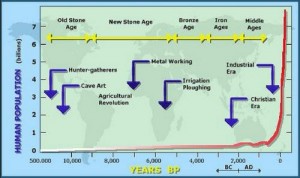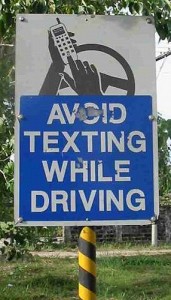Society has always been impacted by technology. Each invention has affected how people relate to one another and how cultures have expanded or ended. Technology impacts how cities grow, where people live, and who owns what. Technologies are the reason a few people are very rich, that people are more social, and that teaching and learning is changing. We are at a crucial time in history where educators can make a difference in how our students interact with one another and make a place for themselves in society.
Historical Perspective
People developed a language so they could communicate and learn from elders through their stories. They invented tools for agriculture, to build homes, and to create weapons for hunting and protection. Civilizations have been impacted by natural disasters, encroachment from other civilizations, and from problems within their own community. Technology not only increased humans’ life span but how we live, how long we live, and how many there are of us.
[Human population growth over time]
The population doubled from 2.5 billion to 5 billion in only 40 years after 1950. The world population passed 6 billion just before the end of the 20th century. It is estimated that the population will reach 8-12 billion before the end of the 21st century. More people means more technology.
People migrated to find a better life. For most of history, only the wealthy had access to literature and a good education. The printing press allowed the masses to receive news, read books, and attend school. Inventions changed the way we worked like the cotton gin where slaves were stolen from Africa to be used as free labor with no rights, and the railroads that were built with Chinese labor who had little or no rights, no property, or a fair wage. Communities developed within large cities to protect and sustain the different cultures.
After World War II, freeway systems led to the suburbs. Public transportation changed when the automobile became part of every family. Television shows replaced dinner conversations. We saw man walk on the moon and the horrors of war in our living rooms.
So Where are We Now?
The Internet and mobile technology are changing the way people interact, work, and learn. Everyone can report the news or share a picture from their cell phone. You can produce your own music, publish your own book, blog your thoughts that you usually keep to yourself, create a website with even personal information, Twitter what you are doing right now, and talk on your cell whenever and wherever you want. We are using technology for our own use yet it infringes on others. Does this technology allow us to respect each other and value each others’ time and work or do just the opposite?
Consider these questions about today’s technology:
- Do you answer your cell phone when you are at a party, in line for coffee, dining with friends, etc.?
- Would your children rather text message instead of talking to your friends face-to-face?
- Do you post to your blog your thoughts and link to others without researching if the information is valid?
- Do your children have a FaceBook profile with links to friends they don’t know?
- Would you rather visit a museum in SecondLife than visit a real museum?
- Do you believe that all music, art, and literature should be free?
Our connections seem personal, but are they? Many young people value the number of friends they have more than the quality of those friendships. The appeal of technology is real. Do you have an iPhone or a Droid? What about an iPad? Today, the arts, artists, and culture do not seem as valued as in the past. Who owns the work? How would the Beatles promote their music today? They probably would create a FaceBook site and give away samples of their work. With a Creative Commons license, they would probably allow others to use but not modify their work. How do artists make money? How does the viewer find this artist if the artist is not tech savvy? How do you know if the artist is the original artist? With the proliferation of social networking tools where everyone can share and publish on the web, artists will have to be innovative and entrepreneurial to be successful.
Web 2.0 allows us to be self-absorbed yet more connected than ever.
“The consequences of Web 2.0 are inherently dangerous for the vitality of culture and the arts. Its empowering promises play upon that legacy of the ’60s–the creeping narcissism … with its obsessive focus on the realization of the self.” . [Andrew Keen’s reference to Web 2.0]
Every day there are new Web 2.0 tools that let you create, publish, and share. This is a time in history we will look back and say either “I wish I had created my own Web 2.0 or mobile app”, “I lost everything because I gave it away” or “what is Web 2.0?”
Okay – so I twitter [twitter.com], blog [barbara.bray.net], and have my own learning community [my-ecoach.com]. I’m not alone. People are leaving landline phones, books, and television by the millions. They use Internet-based services like YouTube or Hulu to watch their favorite shows and Skype to virtually connect — for free. It is a generational shift with even older generations jumping on board. Companies are marketing to a new kind of multinational and navigating the digital Silk Road. The growth of technology in China and India already affects how we use technology just because of the numbers of people involved. Video games have professional leagues with international online contests and self-made celebrities [Major League Gaming: http://www.mlgpro.com/]. Digital fads that are global may work in one country and not in another. Student tutors mentor students in another country. The old hierarchical system is falling away. Textbooks are starting to become open source such as Curriki.com and MIT OpenCourseware. Even marketing is changing. Viral marketing launches companies like Threadless T-shirts where the consumers design what they want. Will our students design what they need to learn? Will teachers learn how to be the digital guide?
Value Arts and Culture
With more people and crowded conditions, new technologies will be necessary to support and sustain us. Let’s also make sure we use these tools to tell and protect our stories. Video, audio, images, and interactive features open doors to worlds and cultures that children could never learn in a book. We need to allow for private spaces for confidential discussions and provide guides for tentative and eager participants. It is our duty as educators to guide students and other educators as they become innovative producers, teach them to become cautious consumers, and learn how they can use these tools to reach their fullest potential. We need to support the arts and artists and value each others culture. Let’s take these next few years to design digital ways to connect us not only to each other but to promote our values, to respect each other, and to encourage innovation as we develop a place for ourselves in the 21st century!
This post was updated from the original post on Rethinking Learning September 2007





[…] of the 60sthe creeping narcissism with its obsessive focus on the realization of the self. …read the full article here Post Info (No Ratings Yet) Loading … Written by Frank, Filed under: Web 2.0 News […]
[…] of Web and Arts #003Technology and Its Impact on Learning | Barbara Bray – Learning …It's not about money, it's culture why companies invest in …World Star Hip Hop the […]
thanks good post
Many thanks for your post, I even learned a lot from it. Excellent content here. Always looking towards new post!
Thanks Barbara, I appreciate your article. I have gained some inputs on my studies on technology and culture